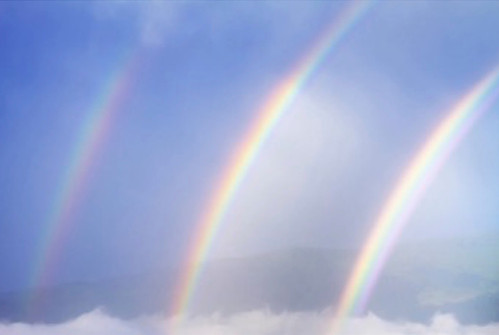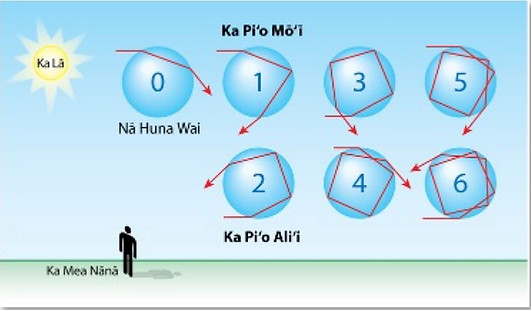
Higher Order Rainbows
Features of higer order rainbows
Higer order bows are those with 3 or more arcs. There is no definition within the Hawaiian dictionary for these types.
Primary trait: A rainbow with 3 or more arcs
Secondary trait: A rainbow with the majority of the color
A third order bow (na shutterstock)
These types of rainbows are indeed extraordinary, however they do appear in some traditional Hawaiian stories, and have also been witnessed by some people here in Hawaii. In the western scientific perspective, witnessing a rainbow with 3 arcs or more is extremely rare. A three arc rainbow is shown above,[1] however the authenticity of this photo may be in question. Finding photographs of higher order rainbows is very difficult due to their scarce appearance.
The order of the rainbow is determined by the number of reflections of the light within the water drops. A primary rainbow is also called a first order rainbow, a double rainbow is also called a secondary rainbow, a rainbow with 3 arcs is a third order, etc.[2]
The rainbow colors are seen as a result of the light rays being directed toward the observer. This can be seen in the diagram above. In other words the observer is able to see the first, second, fifth, and sixth order rainbows. The zeroth, third, and fourth orders are directed away from the observer.[3] Witnessing any higher level rainbow is extremely rare, however, a fifth order was photographed in 2009.[4] The zeroth order rainbow appears behind the observer and is not a true rainbow. It is called a zeroth order glow.[5]
Sometimes, several color bands can be seen below the primary rainbow (Piʻo Mōʻī) and above a secondary arc (Piʻo Aliʻi), these are called supernumerary bows (Piʻo pēpē).[6] These arcs are typically violet and green. The size and spacing of these arcs is variable. These are shown in the pictures below.
Supernumerary bows (na Andrew Hara).
In the scientific view, the reason for the appearance of the supernumerary bows is the size of the water drops of the primary bow and those directly below the primary bow. Some of the light rays that enter the water drops travel a slightly different path and therefore exit the drop in a slightly different band. The result of constructive and destructive interference within this band produces the supernumerary bows. These bands usually produce alternating green and violet colors.[7]
The sky strata that higher order bows appear
The sky strata of the higher order bows is perhaps similar to that of the double rainbow. Namely the lewa lani lewa, ka lewa nuʻu and the lewa lani. Because of their rarity it is difficult to estimate the strata for all the various higher order bows.
Times when higher order bows appear
Despite the scientific belief that rainbows appear only under certain specific geometries, there are many examples within traditional Hawaiian stories and eye-witness accounts of higher order bows appear at other times. Examples of this are shown on the Hawaiian language page for higher order bows on this website.
The signs/omens of higher order bows
There were 3 signs/omens found within the sources analyzed for the double rainbow. There are 7 occurrences of these signs/omens, and the signs concerning a presence were the most numerous (4). The Chi-square goodness-of-fit test was performed on the data, and the result is that the data does not vary significantly from an equal distribution and therefore none of the groups is significantly different than the others from a mathematical perspective. Examples of these signs/omens are not available at this time in English but are shown on the Hawaiian side of the website.
Translation Key
[1] Kākaʻikahi nō ke ānuenue pākoli, a no laila, malia paha, hoʻololi ʻia kēia kiʻi i mea e hōʻike ai i nā piʻo he ʻekolu.
[2] n.d. Higher Order Bows. Accessed 4 2024. https://atoptics.co.uk/blog/higher-order-bows/.
[3] Harold Edens. 2015. "Photographic observation of a natural fifth-order rainbow." Applied Optics (Optical Society of America) 54 (4): B26-B34.
[4] n.d. Higher Order Bows. Accessed 4 2024. https://atoptics.co.uk/blog/higher-order-bows/.
[5] John A. Adam. 2002. "The mathematical physics of rainbows and glories." Physics Reports (Elsevier) 356 (4-5): 229-365. Accessed ʻApelila 2024.
[6] n.d. Higher Order Bows. Accessed 4 2024. https://atoptics.co.uk/blog/higher-order-bows/.
[7] Carl B. Boyer (1987). The Rainbow: From Myth to Mathematics. Princeton, NJ: Princeton University Press.





na Kelly Headrick | Dreamstime.com